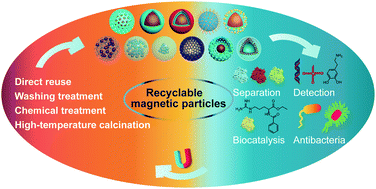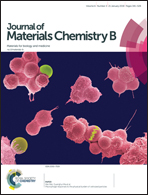Progress of recyclable magnetic particles for biomedical applications
Abstract
Recyclable magnetic particles constitute a class of particles that can be manipulated by external magnetic fields and reused multiple times. These particles consist of a magnetic part and a functional part and have been widely used in the biomedical field, such as in enzyme immobilization, biochemical separation, nucleic acid detection and antibacterial agents, owing to their advantages of convenient operation, high efficiency, mild separation, and easy recycling. In this review, we investigate the research status of recyclable magnetic particles, and discuss their preparation methods, types and recycling methods in detail. According to their structure, existing recyclable magnetic particles are divided into three main types: core–shell structure particles, matrix-dispersed structure particles and hollow structure particles. Each type of recyclable magnetic particle requires a treatment procedure for reuse, which includes direct reuse, washing treatment, chemical treatment and high-temperature calcination. To date, most recycling methods for magnetic particles belong to washing and chemical treatment, and few studies focus on novel magnetic recycling methods, owing to the lack of systemic summary and theoretical studies. We also point out the limitations of preparation and treatment methods, and predict the development direction of recyclable magnetic particles. We predict that recyclable magnetic particles will occupy an important position in the field of sustainable development and environmental protection, and considerable perspectives will be presented for the development of recyclable magnetic particles.

- This article is part of the themed collections: International Year of the Periodic Table: Applications for magnetic materials and Recent Review Articles


 Please wait while we load your content...
Please wait while we load your content...